Varied difficulty levels in AP Inter 1st Year Zoology Model Papers Set 3 cater to students with diverse academic strengths and challenges.
AP Inter 1st Year Zoology Model Paper Set 3 with Solutions
Time : 3 Hours
Max. Marks: 60
General Instructions:
Note : Read the following instructions carefully.
- Answer All questions of Section A. Answer ANY SIX questions in Section B and answer ANY TWO questions in Section C.
- In Section A questions from Sr. Nos. 1 to 10 are of “Very Short Answer Type”. Each question carries TWO marks. Every answer may be limited to 5 lines. Answer all these questions at one place in the same order.
- In Section ‘B’, questions from Sr. Nos. 11 to 18 are of “Short Answer Type”. Each question carries FOUR marks. Every answer may be limited to 20 lines.
- In Section’C’, questions from Sr. Nos. 19 to 21 are of “Long Answer Type”. Each question carries EIGHT marks. Every answer may be limited to 60 lines.
- Draw labelled diagrams wherever necessary in Sections ‘B’ and ‘C’.
Section – A (10 × 2 = 20)
Note : Answer all the questions in 5 lines each.
Question 1.
What is meant by Tautonymy ? Give two examples.
Answer:
The practice of naming the animals, in which the generic name and species name are the same, is called tautonymy. So the name is called tautonym.
e.g : Naja naja (Indian cobra), Axis axis (spotted deer)
Question 2.
Mention any two substances secreted by Mast cells and their functions.
- Heparin – an anticoagulant (Prevents blood clotting).
- Histamine – vasodilators (Cause inflammation in response to injury and infection).
Question 3.
What is Sesmoid bone ? Give an example.
Answer:
Sesmoid bones are formed by ossification in tendons, e.g: Patella (Knee cap)
![]()
Question 4.
What is the Haematocrit value ?
Answer:
The percentage of total volume occupied by RBCs in blood is called haematocrit value.
Question 5.
What is the function of Radula ? Give the name of the group of molluscs which do not possess a radula.
Answer:
The buccal cavity of molluscs contain a file like rasping organ called radula for feeding. It is absent in the class bivalvia or pelecypoda.
Question 6.
Distinguish between Milt and Spawn.
Answer:
a) Mass of eggs released by a female frog into water is called Spawn.
b) Mass of sperms released by a male frog into water is called Milt.
Question 7.
List any two differences between a Flagellum and Cilium.
Answer:
| Flagellum | Cilium |
| 1. The long whip like locomotor organelles are called flagella. | 1. These are small hair like structures found in ciliate protists, genital ducts, respiratory ducts. |
| 2. Flagellum helps only in locomotion. | 2. Cilia serve as organelles or locomotion, food collection and also act as Sensory structures. |
| 3. Flagellum perform undular movement. | 3. Cilia perform pendular movement. |
Question 8.
Define Conjugation with reference to Ciliates. Give two examples.
Answer:
Conjugation is a temporary union between two senile ciliates that belong to two different mating types for the exchange of nuclear material and its reorganization. This is observed in Paramoecium and Vorticella.
Question 9.
What do you mean by parasitic castration ? Give one example.
Answer:
Some parasites cause the degeneration of gonads of the host, making it sterile. This effect is called parasitic castration, e.g : Sacculina (crustacean) causes degeneration of ovaries in the crab carcinus.
![]()
Question 10.
Why are incinerators used in hospitals ?
Answer:
Hospitals generate hazardous wastes that contain disinfectants, harmful chemicals and also pathogenic micro-organisms. Such wastes also require careful treatment and disposal. The use of incinerators (to burn wastes) is essential for disposal of hospital waste.
Section – B (6 × 4 = 24)
Note : Answer any six questions in 20 lines each.
Question 11.
Explain ‘Rivet popper’ hypothesis.
Answer:
What if we lose a few species? Will it affect man’s life? Paul Ehrlich experiments Rivet popper, hypothesis, taking an aeroplane as an ecosystem, explains how removal of one by one ‘rivets’, (species of an ecosystem) of various parts can slowly damage the plane (ecosystem) shows how important a ‘species’ is in the overall functioning of an ecosystem. Removing a rivet from a seat or some other relatively minor important parts may not damage the plane, but removal of a rivet from a part supporting the wing can result in a crash. Likewise, removal of a ‘critical species’ may affect the entire community and thus the entire ecosystem.
Question 12.
Describe the structure of a multipolar neuron with the help of diagram.
Answer:
A neuron usually consists of a “cell body” with one to many dendrites and a single axon.
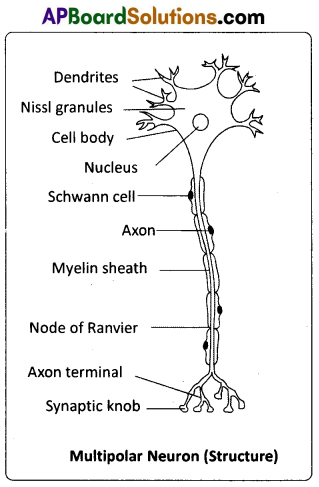
Cell body : It is also called perikaryon, cyton or soma. It contains abundant granular cytoplasm and a large spherical nucleus. The cytoplasm has Nissl bodies (they represent RER, the sites of protein synthesis), neurofibrils and lipofuscin granules (the products of cellular wear and tear, accumulating in lysosomes with age). A group of cell bodies in the central nervous system is called a ‘nucleus’, and in the peripheral nervous system, it is called a ‘ganglion’.
Dendrites:
Several short, branched processes which arise from the cyton are called dendrites. They also contain Nissl bodies and neurofibrils. They conduct nerve impulses towards the cell body (afferent processes).
Axon:
An axon is a single, long, cylindrical process that originates from a region of the cyton called axon hillock. Plasmalemma of an axon is called axolemma, and the cytoplasm is called axoplasm, which contains neurofibrils. However, Nissl bodies are absent. An axon may give rise to collateral branches. Distally it branches into many fine filaments called telodendria, (axon terminals), which end in bulb like structures called synaptic knobs or terminal boutons. Synaptic knobs possess ‘synaptic vesicles’ containing chemicals called neurotransmitters. Axon transmits nerve impulse away from the cyton (efferent process) to an interneuronal or neuromuscular junction called synapse.
Question 13.
Mention any eight general characters of Arachnida.
Answer
Class – Arachnida general characters :
- They are terrestrial.
- Prosoma bears a pair of chelicerae, a pair of pedipalpi and four pairs of walking legs.
- Mesosomal appendages are modified into book-lungs.
- Four pairs of posterior abdominal appendages are modified into spinnerets in spiders.
- Respiratory organs are book.- lungs (scorpions and some spiders), tracheae (some spiders) or both (some spiders).
- Respiratory pigments is ‘copper’ containing haemocyanin.
- Excretory organs are malpighian tubules and coxal glands.
- Development is direct; scorpions are viviparous.
Example : Palamnaeus (scorpion), Aranea (spider), Sarcoptes (itch mite).

![]()
Question 14.
Compare and contrast cartilaginous and bony fishes.
Answer:
| Cartilaginous fishes | Bony fishes |
| 1) Caudal fin is heterocercal | 1) Caudal fin is diphycercal or homocercal. |
| 2) Scales if present placoid scales. | 2) Scales are ganoid, cycloid or ctenoid scales. |
| 3) Endoskeleton is entirely cartilage. | 3) Endoskeleton is bony. |
| 4) Mouth and nostrils are ventral. | 4) Mouth is usually terminal. |
| 5) Digestive tract opens into cloaca, If present. | 5) Digestive tract opens out by anus. |
| 6) Air bladder is absent. | 6) Air bladder Is often present. |
| 7) Fertilization is internal. Mostly viviparous, e.g: Scoliodon. | 7) Fertilization is external. Mostly oviparous, e.g : Catla catla |
Question 15.
Describe the process of transverse binary fission in Paramecium with the help of diagram.
Answer:
During favourable conditions, Paramecium stops feeding after attaining its maximum growth. At first the micronucleus divides by mitosis and the macronucleus divides into two daughter nuclei by amitosis. The oral groove disappears. After karyokinesis, a transverse constriction appears in the middle of the body, which deepens and divides the parent cell into two daughter individuals, the anterior proter and the posterior opisthe. The proter receives the anterior contractile vacuole, cytopharynx and cytosome from its parent individual. It develops posterior contractile vacuole and a new oral groove. The opisthe receives the posterior contractile vacuole of its parent. It develops a new anterior contractile vacuole, cytopharynx, cytostome and a new oral groove. Binary fission is completed in almost two hours, in favourable conditions and paramecium can produce fourenerations of daughter individuals by binary fission in a day.
The transverse binary fission is also called homothetogenic fission, because the plane of fission is at right angles to the longitudinal axis of the body. As it occurs at right angles to the kineties, it is also called perkinetal fission.
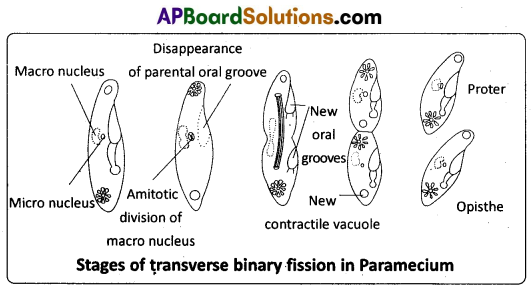
Question 16.
What are the adverse effects of tobacco ?
Answer:
Effect : Smoking increases the carbon monoxide (CO) level and reduces the oxygen level in the blood. Nicotine stimulates the adrenal gland to release adrenaline and nor-adrenajine into blood.
These hormones raise the blood pressure and increase the heart rate. Smoking is associated with bronchitis, emphysema, coronary heart disease, gastric ulcer and increases the incidence of cancers of throat, lungs, urinary bladder etc. Smoking also paves the way to hard drugs. Yet smoking is very pravalent in society, both among young and old. Tobacco chewing is associated with increased risk of cancer of the oral cavity.
Question 17.
Draw a neat labelled diagram of the mouth parts of Cockroach.
Answer:
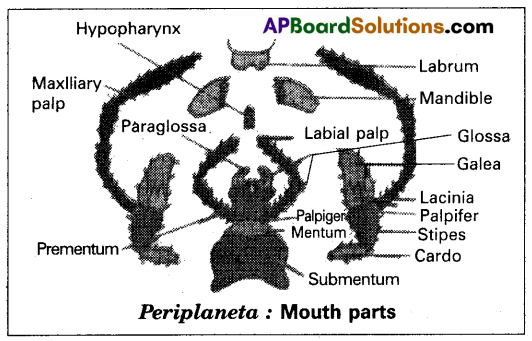
Question 18.
What are the deleterious effects of depletion of Ozone in the stratosphere ?
Answer:
The depletion of ozone is particularly marked over the Antarctic region. This has resulted in the formation of a large area of thinned ozone layer, commonly called as the ‘ozone hole’.
UV radiation with wavelengths shorter than that of UV-B, are almost completely abosorbed by Earth’s atmosphere, provided that the ozone layer is intact. But UV-B damages DNA and may induce mutations. It causes ageing of skin, damage to skin cells and various types of skin cancers. In human eye, cornea absorbs UV-B radiation, and a high dose of UV-B causes inflammation of cornea, called snow – blindness, cataract, etc. Such exposure may permanently damage the cornea.
![]()
Section – C (2 × 8 = 16)
Note: Answer any two questions in 60 lines each.
Question 19.
Describe the life cycle of Plasmodium vivax in man with the help of diagram.
Answer:
Life cycle of Plasmodium in man (The human phase): In man, the Plasmodium reproduces by asexual reproduction called schizogony. It occurs in liver cells (hepatocytes) as well as in RBC. In liver cells, it is called hepatic schizogony and in RBC it is called erythrocytic schizogony.
Hepatic schizogony : This was discovered by Shortt and Garnham. Whenever, a mosquito infected by Plasmodium bites a man, nearly 2000 sporozoites are released into the blood of man through its saliva. Within half an hour, they reach the hepatocytes where they undergo pre-erythrocytic and exoerythrocytic cycles.
Pre-erythrocytic cycle: Whenever the sporozoites reach the liver cells, they transform into trophozoites. Theyfeed on the contents of the hepatic cells, assume spherical shape and attain the maximum size. This stage is called schizont stage. Its nucleus divides several times mitotically, followed by the cytoplasmic divisions resulting in approximately 12,000 daughter individuals called cryptozoites or the 1stgeneration merozoites. They enter the sinusoids of the liver by rupturing the cell membrane of the schizont and the liver cells. This entire process is completed approximately in 8 days. Now these first generation merozoites have two options i.e., they can enter either fresh liver cells and continue exo-erythrocytic cycle or they can enter RBC and continue erythrocytic cycle.
Exo-erythrocytic cycle : If the cryptozoites enter the fresh liver cells, they undergo the changes similar to that of the pre-erythrocytic cycle and produce the second generation merozoites called metacryptozoites. These are of two types – the smaller micro- metacryptozoites and larger macro- metacryptozoites. This entire process is completed approximately in two days. The macro-metacryptozoites attack fresh liver cells and continue another exo – erythrocytic cycle, whereas the micro- metacryptozoites always enter blood stream and attack fresh RBC , to continue erythrocytic cycle.
Prepatent period : The interval between ‘the first entry of Plasmodium into the blood in the form of sporozoites and the second entry of Plasmodium into the blood in the form of cryptozoites is called prepatent period. It lasts approximately 8 days. During this period, the host does not show any clinical symptoms of the disease. It is only a means of multiplication.
Erythrocytic cycle: It was first described by Camillo Golgi. Hence it is also called Golgi cycle. This cycle is initiated either by the cryptozoites of pre-erythrocytic cycle or the micro- metacryptozoites of exp – erythrocytic cycle. In the fresh RBC, these stages assume spherical shape and transform into trophozoites. It develops a small vacuole which gradually enlarges in size, pushing the cytoplasm and nucleus to the periphery. Now the Plasmodium looks like a finger ring. Hence this stage is called signet ring stage. Soon it loses the vacuole, develops pseudopodia and becomes amoeboid stage. With the help of pseudopodia, it actively feeds on the contents of the RBC and increases in size. As a result, the RBC grows almost double the size. This process is called hypertrophy.
The malaria parasite digests the globin part of the ingested haemoglobin and converts the soluble haem into an insoluble crystalline haemozoin. It is called the ‘malaria pigment’ which is a disposable product. During this stage, small red coloured dots appear in the cytoplasm of the RBC known as Schuffners dots. These are believed to be the antigens released by the parasite. Now the Plasmodium loses the pseudopodia, further increases in size, occupies the entire RBC and becomes a schizont. It undergoes schizogony similar to that of the pre-erythrocytic cycle and produces 12 to 24 erythrocytic merozoites. They are arranged in the form of the petals of a rose in the RBC. Hence, this stage is called the rosette stage. Finally the erythrocyte bursts and releases the merozoites along with haemozoin into the blood. This cycle is completed approximately in 48 hours.
Incubation Period : The period between ‘the entry of Plasmodium into the blood in the form of sporozoite and the first appearance of symptoms of malaria in man’ is called incubation period. It is approximately 10 to 14 days.
Formation of gametocytes : After repeated cycles of erythrocytic schizogony, when the number of fresh RBC decreases, some merozoites enter the RBC and transform into gametocytes instead of continuing the erythrocytic cycle. This process generally takes place when the RBCs are present in spleen and bone marrow.
The gametocytes are of two types namely, smaller microgametocytes or male gametocytes and larger macrogametocytes or female gametocytes. The gametocytes cannot undergo further development in man as the temperature and pH of the blood of man are not suitable for further development. These gametocytes reach the blood circulation and wait to reach the next host. They degenerate and die if they are not transferred to mosquito within a week.
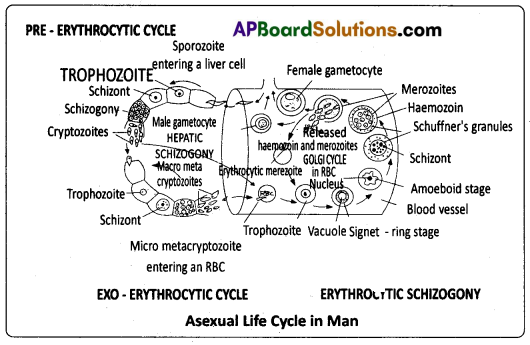
Question 20.
Describe the digestive system of Cockroach with the help of neat labelled diagram.
Answer:
The digestive system of cockroach consists of an alimentary canal and the associated glands. The preoral cavity, surrounded by the mouth parts, is present in front of the mouth. The hypopharynx divides it into two chambers called cibarium (anterior) and salivarium (posterior).
Alimentary canal : The alimentary canal of cockroach is a long tube and is coiled at some places. lt extends between the mouth and the anus. It is divided into three regions, namely, foregut or stomodaeum, midgut or mesenteron and hindgut or proctodaeum. The foregut and hindgut are internally lined by ectoderm. The mesenteron is lined by the endodermal cells.
Foregut of stomodaeum : The foregut includes pharynx, oesophagus, crop, and gizzard. It is internally lined by a chitinous cuticle. Mouth opens into the pharynx, which in turn leads into a narrow tubular oesophagus. The oesophagus opens behind into a thin walled distensible sac called crop. The crop serves as a reservoir for storing food. Its outer surface is covered by a network of tracheae.
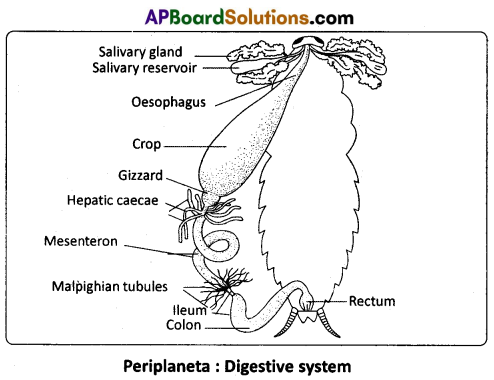
Behind the crop there is a thick walled muscular proventriculus, or gizzard. The chitinous inner lining of the gizzard has six powerful teeth, which form an efficient grinding apparatus. Behind each tooth is a hairy pad, which bears backwardly directed bristles. Among these plates, food is thoroughly ground into fine particles. These food particles are filtered by the bristles. The gizzard thus acts both as a grinding mill and also as a sieve. There Is a membranous projection of the gizzard into the mesenteron in the form of a funnel called stomodeai valve. This valve prevents the entry (regurgitation) of food from the mesenteron back into the gizzard.
Midgut (mesenteron or ventriculus) : The midgut is a short and narrow tube behind the gizzard. It is also called mesenteron or ventriculus. Between the ventriculus and the gizzard, arising from ventriculus, there are six to eight finger like diverticula called hepatic caecae. They are helpful in digestion and absorption of the digested food materials. Ventriculus is functionally divided into an anterior secretory part and a posterior absorptive part.
The secretory part of the ventriculus has many gland cells and it secretes several enzymes. The ‘bolus’ of food in the mesenteron is enveloped by a chitinous and porous membrane called peritrophic membrane, which is secreted by the funnel like stomodeal valve of the gizzard.
Digested food is absorbed into the blood through the peritrophic membrane in the posterior absorptive region of the ventriculus. The peritrophic membrane protects the wall of the ventriculus from hard food particles in the food. The opening of the ventriculus into the hindgut is controlled by a sphincter muscle. It prevents entry of undigested food and uric acid from the hindgut into the midgut.
Hindgut or proctodaeum : The hindgut is a long coiled tube, consisting of three regions namely ileum, colon and rectum, it is internally lined by chitinous cuticle. The ileum that lies behind the mesenteron is a short tube. Six bundles of fine yellow, blind tubules called malpighian tubules open into the ileum near the junction of mesenteron and ileum. Malpighian tubules are excretory in function. Ileum collects uric acid from the malpighian tubules and undigested food from the mesenteron. Ileum opens behind into a long coiled tube called colon. Colon leads into a short and wide rectum, which opens out through the anus. Rectum bears on its inner side six longitudinal chitinous folds called rectal papillae. They are concerned with the reabsorption of water from the undigested food.
Digestive glands : The digestive glands associated with the alimentary canal of cockroach are salivary glands, hepatic caecae and glandular cells of the mesenteron.
Salivary glands : There is a pair of salivary glands attached to the ventrolateral sides of the crop, one on each side. Each salivary gland has two lobes. Each lobe of salivary gland has many lobules called acini. Each acinus is a group of secretory cells called zymogen cells with a small ductule. The ductules of both the lobes of a salivary gland unite to form a common salivary duct on each side.
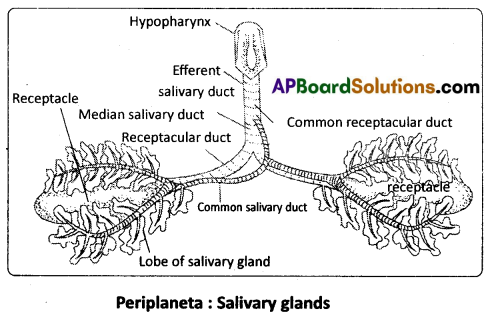
The two common salivary ducts are joined to form the median salivary duct. Between the two lobes of a salivary gland of each side is a sac called salivary receptacle that stores saliva. It leads into a receptacular duct, or ‘reservoir duct’. The receptacular ducts of both the sides are united to form a common receptacular duct, or ‘common reservoir duct’. The median salivary duct opens into the common receptacular duct. Later these two form an efferent salivary duct. The efferent salivary duct opens at the base of the hypopharynx. Acinar cells secrete saliva, which contains starch digesting enzymes such as amylase.
![]()
Question 21.
Describe different types of food chains that existin an Ecosystem.
Answer:
Energy flows into biological systems (ecosystems) from the Sun. The biological systems of environment include several food levels called trophic levels. A trophic level is composed of those organisms which have the same source of energy and having the same number of steps away from the sun. Thus a plant’s trophic level is one, while that of a herbivore – two, and that of the first level carnivore – three. The second and third levels of the carnivores occupy fourth and fifth trophic levels respectively.
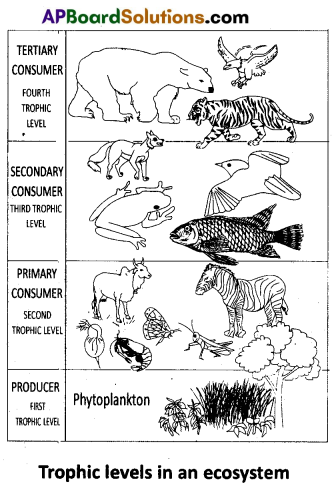
A given organism may occupy more than one trophic level simultaneously. One must remember that the trophic level represents a functional level. A given species may occupy more than one trophic level in the same ecosystem at the same time; for example, a sparrow is a primary consumer when it eats seeds, fruits, and a secondary consumer when it eats insects and worms.
The food energy passes from one trophic levels to another trophic level mostly from the lower to higher trophic levels. When the ‘path of food energy is ‘linear’, the components resemble the ‘links’ of a chain, and it is called ‘food chain’. Generally a food chain ends with decomposers. The three major types of food chains in an ecosystem are Grazing Food Chain, Parasitic Food Chain and Detritus Food Chain.
I. Grazing Food Chain (GFC): It is also known as predatory food chain. It begins with the green plants (producers) and the second, third and fourth trophic levels are occupied by the herbivores, primary carnivores and secondary carnivores respectively. In some food chains there is yet another trophic level – the climax carnivores. The number of trophic levels in food chains varies from 3 to 5 generally. Some examples for grazing food chain (GFC) are given below.
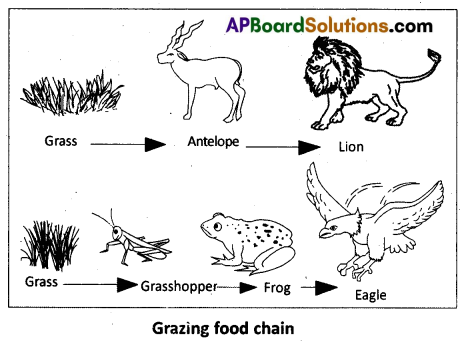
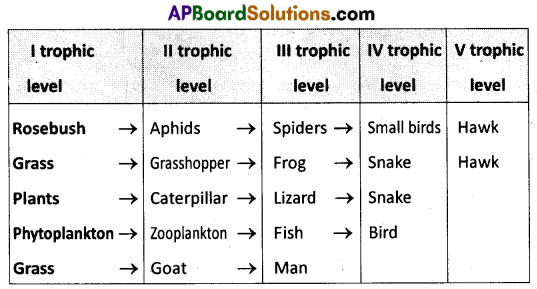
II. Parasitic food chain : Some authors included the ‘parasitic Food Chains’ as a part of the GFC. As in the case of GFCs, it also begins with the producers, the plants (directly or indirectly). However, the food energy passes from large organisms to small organisms in the parasitic chains. For instance, a tree which occupies the 1st trophic level provides shelter and food for many birds. These birds host many ectoparasites and endo-parasites. Thus, unlike in the predator food chain, the path of the flow of energy includes fewer, large sized organisms in the lower trophic levels, and numerous, small sized organisms in the successive higher trophic levels.
III. Detritus Food Chain : The detritus food chain (DFC) begins with dead organic matter (such as leaf litter, bodies of dead organisms). It is made up of Decomposers which are heterotrophic organisms, mainly the ‘fungi’ and ‘bacteria’. They meet their energy and nutrient requirements by degrading dead organic matter or detritus. These are also known as saprotrophs (sapro : to decompose)
Decomposers secrete digestive enzyme that breakdown dead and waste materials (such as faeces) into simple absorbable substances. Some examples of detritus food chains are :
- Detritus (formed from leaf litter) – Earthworms – Frogs – Snakes.
- Dead animals – Flies and maggots – Frogs – Snakes.
In an aquatic ecosystem, GFC is the major ‘conduit’ for the energy flow. As against this, in a terrestrial ecosystem, a much larger fraction of energy flows through the detritus food chain than through the GFC. Detritus food chain may be connected with the grazing food chain at some levels. Some of the organisms of DFC may form the prey of the GFC animals. For example, in the detritus food chain given above, the earthworms of the DFC may become the food of the birds of the GFC. It is to be understood that food chains are not ‘isolated’ always.